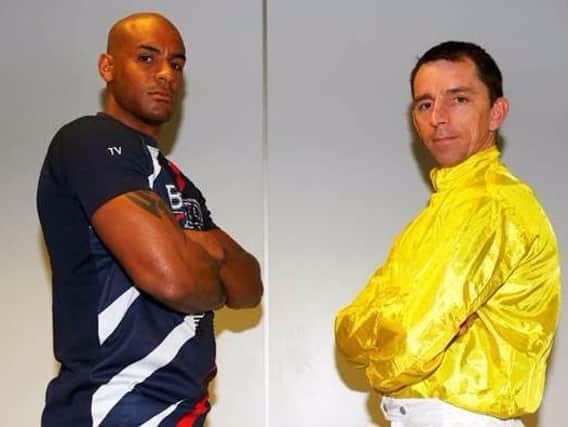Who's fitter? Grand National-winning jockey and pro rugby player face off


But who is the fitter man - jockey Leighton Aspell or Bristol winger Tom Varndell?
The pair faced each other in a series of fitness challenges at Liverpool John Moores University ahead of the Grand National - a race Aspell has won in 2014 and 2015.
Advertisement
Hide AdAdvertisement
Hide AdUnder the guidance of leading sports scientist Dr George Wilson, they had their aerobic fitness, power and strength measured by taking part in a VO Max test, a vertical power jump, a plank and a wall squat.
“We looked at a comparison of a rugby player and a jockey to see how they match up in performance over a series of physical tests. The difference in the physical requirements of a jockey to that of a rugby player are obviously quite stark given that fitness is sports-specific (i.e. muscular endurance for a jockey versus power, strength and speed for a rugby player). However despite the physical difference between them, some of the tests were closer than you would expect," said Dr Wilson.
"Leighton is an excellent example of the 'jockey athlete' and I'd encourage other jockeys to take a leaf out of his book, as there would not be many who could match his level of fitness and conditioning. This shows there is always scope for improvement in fitness and conditioning for jockeys, as is the case for athletes in other sports and, I would suggest, could help jockeys with weight-management."
Aspell, 40, rides daily and also spends time running and in the gym.
Advertisement
Hide AdAdvertisement
Hide Ad“I’d say that my general fitness levels were above average based on the amount of exercise I do. I ride horses every day and if I am not I will head to gym or go running. We were tested all round, our core and legs plus our heart and lungs on the VO2 max test. I was really pleased with the results and I thought it was a really interesting exercise to compare the abilities from two different sports – Tom is certainly a tough competitor,” he said.
Varndell, 31, who broke the Premiership try scoring record in January and has four England caps, added:
“We’re in the middle of season at the moment, we have one day off a week from training and my fitness is closely monitored by the club. Being a winger I need to be powerful and quick, so I was hoping to score well in that area. However Leighton is incredibly fit and it took all my competitive nature to keep with him on some of the tests. I am a big fan of horseracing and this has given me a renewed appreciation for how tough and resilient the riders are.”
The test results were as follows:-
VO2 Max Test
VO2 max is a gauge of the maximum volume of oxygen that an athlete can use during physical exertion. It is measured in millilitres per kilogramme of body weight per minute (ml/kg/min).
Advertisement
Hide AdAdvertisement
Hide AdAs effort increases during exercise, the volume of oxygen you take in to produce energy (and thus the rate you exhale carbon dioxide) increases. However there comes a point in all athletes where they reach a maximum level of oxygen consumption, and any increase in exercise or intensity will not lead to a further increase in oxygen consumption. When this level is reached it is called VO2 Max.
Leighton and Tom were placed on a treadmill running at 8km/h with the incline of the treadmill increasing by 2% every two minutes.
Result: Aspell 65ml/kg/min. Varndell 51 ml/kg/min
Power Jump Test:
The power jump test is a physical fitness test that is used to demonstrate power in the lower body. The main goal of the test is to measure how high an athlete can jump from a standing position based on their explosive lower limb power.
Result: Aspell 39cm, Varndell 69cm
The Plank Test:
The plank test, another isometric assessment, is a simple fitness test of core muscle strength. The plank test measures the control and endurance of the back/core stabilizing muscles. A bit like the press up position, the upper body is supported off the ground by the elbows and forearms, with legs straight and the weight taken by the toes. The hip is lifted off the floor creating a straight line from head to toe – this position is held for as long as possible.
Result: Aspell 3min 28secs, Varndell 3min 31secs
The Wall Squat:
Advertisement
Hide AdAdvertisement
Hide AdAn isometric test designed to measure the strength endurance of the lower body, particularly the quadriceps muscle group. Standing comfortably against the wall with feet approximately shoulder width apart, the back slides down so the hips are at a 90° angle where the position is held for as long as possible.
Result: Aspell 2min 06secs, Varndell 1min 49secs